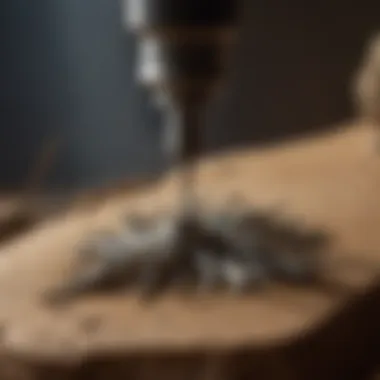Unlocking the Power of Dremel Drills: A Guide for Rock and Fossil Enthusiasts


Rock and Fossil Identification
As intrepid rock and fossil collectors embark on their quest for geological treasures, understanding the spectrum of rocks and fossils becomes paramount. Various types of rocks and fossils await discovery, each holding distinct characteristics that warrant careful observation. From sedimentary to igneous varieties, these geological specimens offer a window into the Earth's history, showcasing intricate patterns and textures molded over millennia. Determining the types of rocks and fossils encountered requires a keen eye attuned to the nuances of geology, employing tools such as magnifiers and field guides to aid in precise identification.
Collecting Tips and Techniques
In the realm of rock and fossil collection, adopting best practices is essential to honor both the specimens and the environment. Seasoned collectors advocate for ethical collecting, emphasizing the importance of leaving minimal impact on natural sites while extracting specimens. Locating prime collecting sites involves research and exploration, uncovering hidden gems embedded in the Earth's tapestry. Extracting specimens safely requires patience and precision, utilizing tools like chisels and brushes to carefully unearth fragile fossils or minerals without causing damage.
Preservation and Display
Preservation stands as a cornerstone in the world of rock and fossil collection, ensuring these geological wonders endure for generations to come. Techniques like consolidating fragile rock layers and fossil structures aid in maintaining their integrity over time. Proper storage methods involve archival materials to shield specimens from environmental degradation, safeguarding their scientific and aesthetic value. Creative display ideas offer enthusiasts an opportunity to showcase their collections artistically, highlighting the beauty and uniqueness of each rock and fossil through innovative exhibition setups.
Geological Insights
Delving deeper into the scientific landscape, understanding geological formations and processes enhances appreciation for rocks and fossils. Unraveling the historical significance of these specimens unveils their role as storytellers of epochs past, shedding light on Earth's evolution through the ages. Noteworthy discoveries in the field contribute to humanity's geological knowledge, unveiling new facets of our planet's rich geological history. By exploring these geological insights, collectors deepen their connection to the Earth's narrative, bridging past and present through the study of rocks and fossils.
Introduction to Dremel Drill
In the realm of rock and fossil collection, the Introduction to Dremel Drill serves as a pivotal point of entry into a world of precision and craftsmanship. Understanding the fundamental concepts behind the Dremel Drill is essential for enthusiasts looking to elevate their collecting experience. This section delves deep into the intricacies of this versatile tool, shedding light on its pivotal role in the art of rock and fossil manipulation. By grasping the core principles of the Dremel Drill, collectors can unlock a myriad of possibilities in shaping, carving, and detailing their prized specimens.
What is a Dremel Drill?
Origin and Evolution
The narrative of Origin and Evolution within the Dremel Drill landscape encompasses a rich tapestry of innovation and utility. Tracing back to its roots, the Dremel Drill has evolved from humble beginnings to become a cornerstone tool for rock and fossil collectors worldwide. The evolution of this tool showcases a relentless pursuit of perfection, culminating in a sleek and efficient design that caters to the diverse needs of enthusiasts. Its adaptability and durability stand out as key characteristics, underpinning its status as the go-to choice for intricately shaping and refining rock and fossil specimens. Embodying precision and reliability, the Origin and Evolution of the Dremel Drill propel it to the forefront of tools favored by collectors seeking top-tier performance.
Basic Components


Delving into the Basic Components unveils the heart of the Dremel Drill, laying bare its inner workings that drive its exceptional performance. Each component plays a crucial role in enhancing the functionality of the tool, offering users a seamless experience in their rock and fossil manipulation endeavors. From the motor to the chuck, every element is meticulously crafted to deliver optimal results, aligning with the high standards expected by discerning collectors. The unique feature of customizable attachments adds a layer of versatility, allowing for a tailored approach to different projects. While its advantages in precision work are undisputed, users may need to exercise caution to prevent overheating during prolonged usage, a minor drawback amidst its stellar performance in enhancing rock and fossil detailing.
Types of Dremel Drills
Diving deep into the world of Dremel drills, understanding the various types becomes crucial for rock and fossil collectors. In this context, selecting between corded and cordless Dremel drills is a decision that greatly impacts performance and convenience. Corded drills, known for their consistent power supply, are ideal for prolonged use without the need for recharging. On the other hand, cordless drills offer greater portability, enabling users to move freely around their workspace. Both types have distinct advantages and considerations that need to be carefully weighed based on the collector's specific needs and preferences.
Corded vs. Cordless Dremel Drills
Features and Benefits
When evaluating corded versus cordless Dremel drills, key considerations come into play. The corded option provides constant power, ensuring uninterrupted operation for intensive tasks. It eliminates the hassle of charging and offers higher torque levels for tougher materials. Cordless drills, however, offer unmatched portability and flexibility, enabling collectors to work in remote locations without power outlets. They are lightweight and easier to maneuver, enhancing comfort during extended periods of use. Understanding these features and benefits is essential for collectors to choose the most suitable option for their projects.
Usage Comparison
Exploring the usage comparison between corded and cordless Dremel drills reveals unique insights. Corded drills excel in heavy-duty applications that demand continuous power, making them ideal for large-scale projects requiring sustained performance. Conversely, cordless drills shine in scenarios where mobility and convenience are top priorities. Their versatility allows collectors to work on diverse projects without being tethered to a power source. While corded drills boast consistent power output, cordless models offer unmatched freedom of movement. By weighing these usage factors, collectors can determine which type aligns best with their intended work requirements, enhancing efficiency and productivity.
Key Features and Functions
Diving deep into the realm of Dremel drills reveals a myriad of key features and functions that significantly impact the world of rock and fossil collectors. The intricate design of Dremel drills incorporates various elements that are crucial for enhancing precision and efficiency in work processes. One of the prominent aspects that make Dremel drills stand out is their versatility, allowing users to seamlessly switch between different attachments and accessories to cater to diverse rock and fossil tasks. Additionally, the ergonomic design of these tools ensures comfortable handling during extended periods of operation, reducing fatigue and enhancing overall user experience. Moreover, the robust construction of Dremel drills guarantees durability and longevity, making them a reliable companion for rock and fossil enthusiasts seeking high-performance tools for their collection endeavors.
Variable Speed Settings
Unveiling the significance of variable speed settings in the realm of rock and fossil work sheds light on a crucial aspect that significantly influences the precision and quality of detailed tasks. The flexibility offered by variable speed settings empowers users to adjust the drilling speed according to the hardness of the material being worked on, allowing for tailored and controlled operations. This feature proves to be indispensable in delicate rock and fossil work, facilitating intricate detailing and shaping with utmost accuracy. The adaptability of variable speed settings caters to a wide range of projects, from cleaning and polishing fossils to carving intricate designs on rocks. Its user-friendly interface ensures seamless navigation through different speed settings, enhancing user control and efficiency in handling various tasks. Integrating variable speed settings into the workflow of rock and fossil collectors elevates their work standards by providing them with the precision and flexibility required to achieve remarkable results in their endeavors.
Applications in Rock and Fossil Collection
Applications in Rock and fossil collection play a pivotal role in utilizing Dremel Drills effectively for enthusiasts. With a myriad of techniques at their disposal, collectors can elevate their craftsmanship to new heights. From minor cleaning to intricate detailing, these applications cater to various needs within the realm of rock and fossil manipulation. Understanding the nuances of each application is essential for enthusiasts looking to refine their collection methodologies.
Preparation Techniques


Cleaning and Polishing
Cleaning and Polishing hold substantial importance in the world of rock and fossil collection. These techniques are vital for enhancing the aesthetic appeal of specimens and ensuring their longevity. The meticulous process of Cleaning and Polishing involves removing debris, dirt, and imperfections from the surface of rocks and fossils. This not only reveals the true beauty of the specimen but also allows for better inspection and study. Enthusiasts favor Cleaning and Polishing for its ability to restore the natural luster of rocks and fossils, making them ideal for display or research purposes.
Shaping and Carving
Shaping and Carving represent advanced techniques in rock and fossil manipulation. These methods involve sculpting raw materials to achieve desired shapes and forms. With Dremel Drills, enthusiasts can intricately carve intricate patterns, intricate engravings and unique shapes. The precision offered by Shaping and Carving allows collectors to unleash their creativity and bring their visions to life. While these techniques demand patience and skill, the results are truly rewarding, producing bespoke pieces that stand out in any collection. collectors must master the art of Shaping and Carving to unlock the full potential of their rock and fossil specimens.
Safety Precautions and Maintenance
In the realm of rock and fossil collection, understanding the significance of safety precautions and maintenance is paramount. Safety precautions serve as the backbone of any activity involving tools, ensuring the well-being of the user and the longevity of the equipment. When it comes to Dremel drills, being diligent about safety not only protects the operator from potential hazards but also safeguards the integrity of precious rocks and fossils being worked on. Proper maintenance of the Dremel drill not only enhances its performance but also prolongs its lifespan, allowing enthusiasts to continue their craft seamlessly.
For rock and fossil collectors embarking on their journey, investing time in learning and applying safety measures is non-negotiable. Safety gear plays a pivotal role in this arena, mitigating risks and providing a layer of defense against accidents. The pulsating heartbeat of safety gear lies in its ability to shield the user from debris, dust, and inadvertent tool slips during intricate work. By donning appropriate safety gear, collectors can delve into their projects with confidence, knowing that they are shielded from harm and can fully concentrate on the task at hand.
Importance of Safety Gear
Protective Measures:
Delving deeper into the realm of safety gear, we encounter the crux of protection - protective measures. These measures encompass a spectrum of gear, from goggles to gloves, earmuffs to masks, all serving the unified purpose of safeguarding the collector. The essence of protective measures lies in their ability to create a barrier between the user and potential harm, ensuring that moments of creativity and precision remain uninterrupted by safety concerns.
The quintessence of protective measures lies in their ergonomic design, crafted with the user's comfort and safety at the forefront. Lightweight yet sturdy, these measures seamlessly integrate into the collector's workflow, enhancing adaptability without compromising on protection. The versatility of protective measures shines through as they cater to various working conditions and requirements, proving to be a versatile and indispensable companion for rock and fossil enthusiasts utilizing Dremel drills.
Navigating the terrain of protective measures unveils the undeniable advantage of heightened safety without impeding productivity. However, like all tools, protective measures bear their own set of considerations, be it maintenance routines or ensuring proper fit. These aspects, when meticulously addressed, fortify the resilience and effectiveness of protective gear, ensuring that collectors can embark on their creative ventures with peace of mind.
Advanced Tips and Techniques
Diving into the realm of advanced tips and techniques is crucial for Rock and Fossil Collectors utilizing Dremel Drills. These techniques serve as the cornerstone of intricate detailing and precision work. By exploring this segment, enthusiasts can elevate their craft to unmatched levels. Understanding the nuances and intricacies of these advanced methodologies is paramount for those seeking excellence in their rock and fossil manipulation endeavors. With a keen focus on detail and precision, these techniques enable collectors to imprint their unique artistry onto each piece they work on.
Precision Work


Engraving
Engraving is a pivotal aspect of precision work when utilizing a Dremel Drill in rock and fossil collection. Its ability to carve intricate designs and markings onto surfaces opens up a world of creative possibilities. The precision offered by engraving allows collectors to add personalized touches to their specimens, enhancing their aesthetic appeal. The fine detailing achievable through engraving showcases the skill and artistry of the collector. However, mastering engraving requires steady hands and a meticulous approach to ensure the desired outcome aligns with the collector's vision.
Detailing
Detailing plays a significant role in refining the overall presentation of rock and fossil collections. It involves the minute finishing touches that elevate a piece from simple to extraordinary. Whether it's enhancing textures, emphasizing contours, or smoothing out rough edges, detailing is the hallmark of a meticulous collector. The attention to detail exemplified in this process sets apart a mediocre collection from a truly exceptional one. While detailing can be time-consuming, the results speak volumes about the dedication and passion invested in each specimen. However, it's essential to strike a balance between enhancing authenticity and preserving the integrity of the original rock or fossil structure.
Choosing the Right Dremel Drill for Your Needs
In the vast expanse of options available, selecting the most suitable Dremel drill is a pivotal decision that can significantly impact your rock and fossil collecting endeavors. Choosing the right tool ensures precision and efficiency in your work, ultimately enhancing the quality of your output.
Factors to Consider
Project Requirements: Unveiling the Scope
One of the primary considerations when opting for a Dremel drill is evaluating your project's specific requirements. Whether your task involves delicate detailing or robust carving, discerning the intricacies of your project can guide you in selecting the appropriate drill model. Project requirements play a central role in determining the ideal tool for the job. Engineers and artists alike look for versatility in their tools, seeking a balance between power and precision to accomplish their envisioned outcomes.
Budget Constraints: Balancing Affordability and Quality
A crucial aspect that influences your choice of a Dremel drill is the budget at your disposal. As much as features and capabilities are essential, staying within budgetary limits is a prudent approach. Budget constraints necessitate a thoughtful evaluation of cost-effectiveness without compromising on desired functionalities. While high-end models may offer advanced features, mid-range options can often cater to the needs of hobbyists and professionals alike, striking a harmonious chord between cost and quality.
Navigating the realm of Dremel drills involves a careful analysis of project demands and financial boundaries. By aligning your project requirements with budget considerations, you can pinpoint the optimal tool that resonates with your specific needs and aspirations.
Conclusion
In the grand tapestry of rock and fossil collection, the [Conclusion] serves as the cornerstone that ties together the intricate threads of knowledge and practical application discussed throughout this comprehensive guide. It is not merely a summary but a reflection on how the insights shared can deeply enrich and transform the collecting experience. By elucidating the essence of the Dremel Drill in rock and fossil manipulation, enthusiasts can grasp the significance of precision and innovation in their endeavors. Understanding the implications of selecting the right tool for the right job can lead to unparalleled results, underscoring the artistry and scientific prowess intertwined in this niche pursuit. Thus, the importance of the [Conclusion] lies in its ability to crystallize the nuances of the craft, igniting a passion for exploration and creation among collectors of all levels.
Enhancing Your Collecting Experience
Doubling as a tool of precision and versatility, the [Enhancing Your Collecting Experience] section delves deeply into the myriad benefits that adept handling of a Dremel Drill can bestow upon rock and fossil enthusiasts. At its core, the [Summary of Benefits] encapsulates the crux of this transformative process, offering a glimpse into the enhancements it brings to the overarching collecting experience. The pivotal role played by [Summary of Benefits] hails from its unmatched ability to elevate the quality and intricacy of rock and fossil manipulations with unerring finesse. Its reputation as the go-to choice resonates not only with novices seeking a foothold in the field but also with seasoned collectors aiming for unparalleled results.
Summary of Benefits
Exploring the chambers of the [Summary of Benefits] illuminates a world where efficiency meets excellence in the realm of rock and fossil manipulation. Its crowning characteristic of seamless adaptability across various substrates underscores its indispensable nature in this domain. Noteworthy for its ergonomic design and intuitive operation, the [Summary of Benefits] imparts a tactile experience that marries functionality with user-friendliness seamlessly. This distinctive feature sets it apart as a frontrunner, offering a plethora of advantages such as enhanced control, reduced fatigue, and unparalleled precision in detailed intricate work. However, amidst its virtues, occasional drawbacks materialize, notably in its power consumption and skill demand, thus urging users to balance proficiency with caution when employing this tool within the context of the broader narrative of this article.







